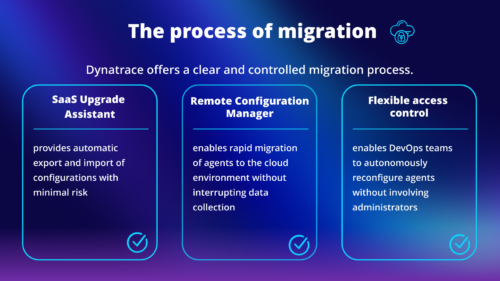INDEX.PHP: Maximizing observability: Why you should migrate Dynatrace to the cloud

Modern IT infrastructure is becoming increasingly complex, while the requirements for the quality of digital services are getting higher. In this scenario, observability is no longer just a technical component; it’s a strategic necessity for business continuity, efficiency, and scalability.
If you already use Dynatrace, switching to its SaaS version is a logical step to unlock the full potential of the platform.
Let’s discuss how and why to do it — keep on reading!
Migrating to Dynatrace SaaS: benefits for business
The cloud version of Dynatrace offers the same powerful observability capabilities as the on-premises (managed) version. However, it has many crucial advantages:
Fast access to innovations: new features and updates become available immediately after release
Flexibility and scalability, allowing you to easily adapt the system to your business needs, regardless of the size or complexity of your IT landscape
Reduced infrastructure and maintenance costs: platform support and upgrades are fully handled by the Dynatrace team
Increased security and compliance with standards (ISO 27001, SOC 2, GDPR, etc.), which is especially important for organizations with high data protection requirements
Together, these capabilities help DevOps teams, CIOs, and technology managers focus on business development rather than maintenance.

The migration takes place in stages. First comes planning, then configuration migration and agent migration. Finally, there’s activation of observability in SaaS. Thus, this process guarantees a safe and efficient transition.
SaaS: Kubernetes for Observability
If you have already moved to Kubernetes or CI/CD practices, moving to Dynatrace SaaS is the next step in your development.
You will be able to replace manual management with an automated, flexible, and scalable model.
What does this mean? Less operational hassle, more control and faster implementation!
To sum it up
The cloud version of Dynatrace is the next generation of observability: continuous, secure, and flexible.
The Dynatrace migration to the cloud is an evolutionary, strategic decision that has become possible in modern realities. That’s why the answer to the question “Why should I migrate Dynatrace to the cloud?” is this: because migration will help your business keep up with modern technology, improve service reliability, and move forward with confidence.
 Austria
Austria  Azerbaijan
Azerbaijan  Bosnia and Herzegovina
Bosnia and Herzegovina  Bulgaria
Bulgaria  Croatia
Croatia  Czech Republic
Czech Republic  Denmark
Denmark  Estonia
Estonia  Finland
Finland  Georgia
Georgia  Germany
Germany  Hungary
Hungary  Kazakhstan
Kazakhstan  Kyrgyzstan
Kyrgyzstan  Latvia
Latvia  Lithuania
Lithuania  Moldova
Moldova  Montenegro
Montenegro  North Macedonia
North Macedonia  Norway
Norway  Poland
Poland  Romania
Romania  Serbia
Serbia  Slovakia
Slovakia  Slovenia
Slovenia  Sweden
Sweden  Switzerland
Switzerland  Tajikistan
Tajikistan  Turkmenistan
Turkmenistan  Ukraine
Ukraine  Uzbekistan
Uzbekistan 